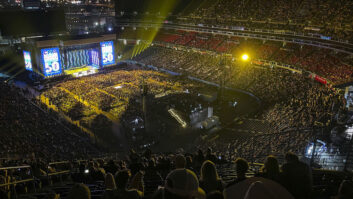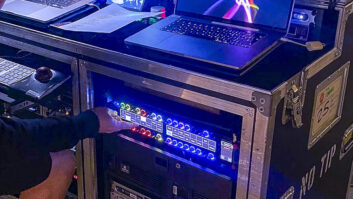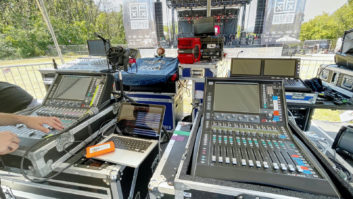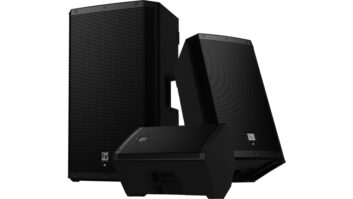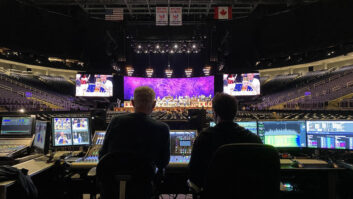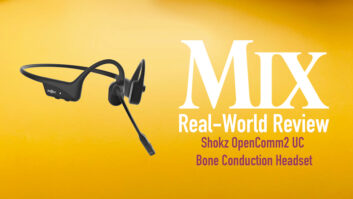When outfitting the outdoor stage in NYC’s Times Square for the CBGB Festival, producers faced the challenge of providing enough wireless for the stage, and avoid interference from the numerous other channels in the city. NEW YORK CITY—Open-air events in inner city areas can present numerous challenges, not the least of which is keeping the sound contained in order to keep the local residents happy. At the free one-day CBGB Music and Film Festival in New York City’s Times Square last year, the main challenge was not simply to control the coverage pattern, but additionally the use of RF links to the delay speaker towers—enabling a very quick PA system set-up—in an intensely dense wireless environment.

Because of the large number of Broadway theaters, television studios and other heavy RF users in the vicinity of Times Square, the area is notoriously challenging for temporary wireless system use. “But our team knocked it out of the park,” says Kevin Mignone, president of KM Productions, based in Hicksville, NY.
Mignone’s company, which provided sound production for the show (featuring Jane’s Addiction, Devo, We Are Scientists and others), utilized RF communications equipment to transport signals to the PA system delay towers. “We had 12 delay towers with in-ear receivers and transmitters, as well as our wireless network, and 18 channels of wireless on each stage, completely bulletproof throughout the entire performance.”
The two stages constructed for the festival, designated North (the B stage, at 52nd Street) and South (main stage, at 46th Street), were equipped with d&b audiotechnik systems. “Every single component on the stages was d&b,” reports Mignone. “The mains were J Series systems with J-Subs. The monitors on both stages were M6s, we had M2s for drum fills and side fills, plus a couple of Q-Subs, and there was a P7 rig on the main stage for the main side fills.”
All the delay systems comprised four d&b V8/V12 combinations. “We partnered up with a company that we’re very close with out here on Long Island—Wireless Sound, and company president Aaron Gennett—to help develop this system of wireless communication, both signal and network, throughout the wireless delay towers that were spread out through Times Square,” he explains. “It was definitely an intensive R&D process. We closed down our entire warehouse complex and tested it up to 300 feet. Times Square is a little less friendly RF environment than Hicksville, but at least it gave us the ability to troubleshoot some things so that we were able to avoid them onsite.”
Wireless Sound’s solution involved RF Venue CP Beam helical antenna systems firing down the left and right sides of the main stage to the delay towers across 12 frequencies, with full redundancy. Each tower housed Shure PSM 1000 and UR4 IEM receivers with an RF Venue Diversity Fin antenna refiring to the next tower.
“We were able to monitor all the d&b D80 amplifiers that were at each tower and assign the inputs that they were seeing,” says Mignone. “Because the PSM is a stereo pack, we were able to give it two channels of input, giving us the ability to monitor the PSM and the UR 4 via [Shure] Wireless Workbench [system management software]. So if any frequency started to get inter-modulated or started to drop out, we could change the frequencies via the computer at front of house on the main stage, and then alert the amplifier to change the input to the other channel we were reserving so that we would have minimal to no dropout time.”
Since the event was taking place on one of the busiest thoroughfares in Manhattan, time was very much an issue for the production crews. “We began loading in at 11:00 p.m. the night before the show, but were not permitted to make any noise until 9:00 a.m.—and the first band went on at 11:00 a.m. So we tuned eight city blocks of PA in 45 minutes with six system techs on Clear-Comms, and got the whole rig time-aligned, frequency analyzed, and done, for three soundchecks, and then started the show at 11:30 a.m.”
As for sound coverage, says Mignone, “We did our best to keep the reflections off of the buildings, just so there weren’t other wave patterns to be concerned with, and there weren’t many sources other than the ones we were pointing for people to hear it from. So we were dealing with essentially one arrival time from one side of the street all the way down to the next.
“And the other benefit was that the light weight of the V Series made us able to use these custom line array towers that were engineered by the event producer to essentially selfcontain all of this into a three-foot by three-foot platform. It’s something that the Times Square Alliance has never seen before. It certainly turned a lot of heads when 12 towers went up in two and a half hours.”
KM Productions
d&b audiotechnik
www.dbaudio.com Shure
